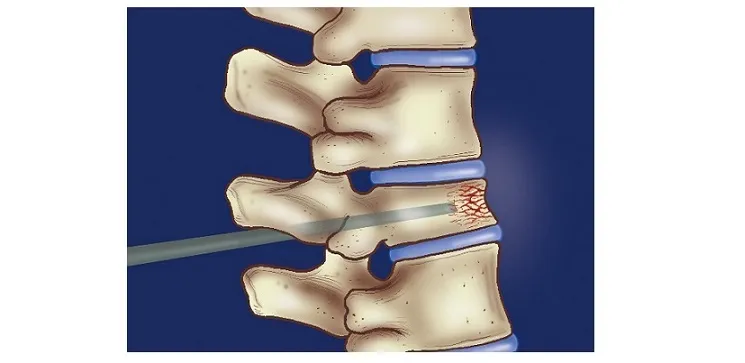
Vertebroplasty
Vertebroplasty in Nagpur A procedure, widely regarded as minimally invasive, it is mainly known to be performed in the name of treatment against compression fractures within the spine.
Relieve pain due to an osteoporotic fracture or spinal tumor and holds the bones together so they do not collapse.
Vertebroplasty is a minimally invasive medical treatment for compression fractures of the spine due to most common causes such as:
1. Osteoporosis
2. Spinal tumors
3. Trauma
This procedure generally includes injection of a type of cement, known as polymethylmethacrylate, PMMA in the fractured vertebra in order to:
1. Stabilize the spine
2. Relieve pain
3. Prevent additional collapse
This procedure is usually done under local anesthesia and may take anywhere from 1 to 2 hours. A thin needle will be inserted through the skin and, guided by an X-ray or CT, advanced to the fracture site. Cement is then injected into the vertebral body, and, in a matter of minutes, hardens to provide fixation.
What Is a Vertebroplasty?
Vertebroplasty is a low-invasive medical procedure where the treatment of spinal compression fracture, commonly caused by osteoporosis, tumors, and trauma, is performed. During the process:
A thin needle, which is guided through an X-ray or CT scan, penetrates the skin to enter the fractured vertebra.
Cement, special for the procedure- polymethylmethacrylate, PMMA- is injected into the vertebra, stabilizing the spine and relieving pain.
The hardening cement takes just a few minutes and offers support and prevents a further collapse.
Vertebroplasty is conducted with the aim of:
Reducing pain and discomfort in the back
Restore vertebral height and shape
Preventing further fracture or collapse
Improving ambulation and quality of life
It is usually performed under local anesthesia and should take between 1-2 hours. In general, a patient with significant pain or disabling mobility caused by the compression fracture of the spine would be a candidate for this procedure. Evaluate by consulting a doctor or spine specialist to determine appropriate treatment.
Benefits:
- Immediate or rapid pain relief (within 24–48 hours).
- Stabilization of the vertebra.
- Minimally invasive with a short recovery time.
- Pain Relief: Most patients experience significant pain relief within 24 to 48 hours.
- Improved Mobility: Patients can typically resume normal activities soon after recovery.
- Minimally Invasive: The procedure involves a small incision, reducing recovery time and hospital stays.
- Bone Stabilization: By reinforcing the fractured vertebra, vertebroplasty helps prevent further collapse and deformity.
Risks:
- Infection.
- Bleeding or hematoma formation.
- Cement leakage, which could lead to nerve or spinal cord damage.
- Allergic reactions to the materials.
- Cement Leakage: In rare cases, the cement may leak out of the vertebra, potentially causing nerve or spinal cord damage.
- Infection: Though rare, there is the small risk of infection.
- Bleeding: Some bleeding may occur, especially in a people with blood clotting disorders.
- Allergic Reactions: To the materials used, such as bone cement.
- Fractures in Adjacent Vertebrae: Sometimes the additional pressure can cause fractures in nearby vertebrae.
Indications for Vertebroplasty:
- Persistent, severe pain from vertebral compression fractures that do not respond to conservative treatments (e.g., bed rest, medications, physical therapy).
- Fractures that are less than 8 weeks old.
- Vertebral collapse that compromises spinal alignment or function.
Procedure:
- Persistent, severe pain from vertebral compression fractures that do not respond to conservative treatments (e.g., bed rest, medications, physical therapy).
- Fractures that are less than 8 weeks old.
- Vertebral collapse that compromises spinal alignment or function.
Recovery:
- Immediate: Patients can usually walk within hours of the procedure and leave the hospital the same day or the day after.
- Long-Term: Most people return to normal activities within a few days, but heavy lifting and intense physical activity should be avoided initially.
Alternatives:
- Kyphoplasty: Similar to vertebroplasty but involves inserting a balloon into the vertebra first to restore height before injecting cement.
- Conservative Treatments: Rest, pain medications, and physical therapy may still be viable for some patients without undergoing surgery.
What procedures Vertebroplasty?
A typical vertebroplasty procedure usually involves the following general steps:
Preparation: The patient will be placed on the procedure table where the patient lies in a face down position. The skin will be cleaned and draped. The patient will be given concomitance informed consent, and local anesthesia and conscious sedation will also be administered.
Insertion of a needle: The skin will be penetrated by a small needle named the trocar, or the needle will penetrate the vertebral body. The fluoroscopy and the CT scan guides the needle for correct positioning.
Injection of cement: Poly-methylmethacrylate, PMMA cement will then be injected via the needle.
In-filling the cement to the vertebra body
4. Setting of Cement:
Allow 10-15 minutes to a cement to harden
5. The removal of the Needle
Take out the needle and the trocar
6. After-procedure care
Instruction and follow-up care after the procedure
Other forms of vertebroplasty are:
1. Kyphoplasty: making use of a balloon to expand the vertebral body before injecting cement into it.
2. Radiofrequency kyphoplasty: a procedure in which radiofrequency energy is utilized to heat and mold the cement.
3. Stenting vertebroplasty: A stent is put in support of the vertebral body
Note: Steps might vary from case to case and from clinician to clinician.
At our Neurosys Multispeciality Center, we perform several key procedures including Craniotomy, which is primarily for the excision of brain tumors; V-P Shunt Surgery for treating hydrocephalus; surgeries for epilepsy; and operations targeting brain stem glioma. Beyond these, we offer a range of other neurosurgical services. If you have any questions that are not answere, please contact us through our Contact Us or Book your Appointment.
